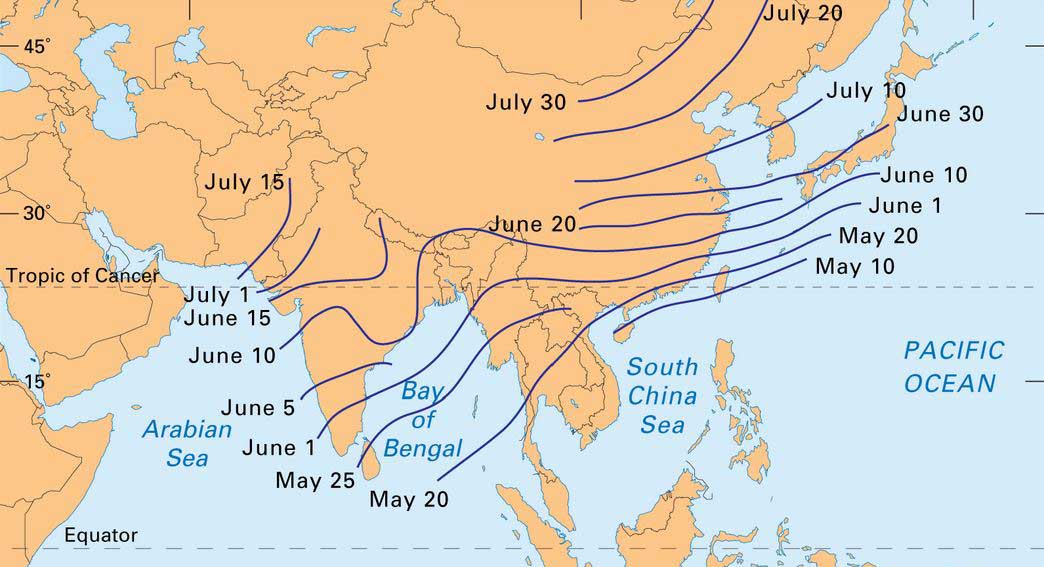The origin of the word monsoon is believed to be the Arabic word mawsim which means the season. Needless to say, monsoon has a significant impact on patterns of the season. Here, we will discuss in details monsoon, its types, causes and impact.
What is Monsoon?
Definition of monsoon: Monsoon is a periodic wind system that reverses its direction according to the change in season. This seasonal reversal of wind is accompanied by precipitation. The reversal occurs due to the difference in temperature of the ocean and the landmass. It travels through the sea to the land in summer and from land to the sea in winters.
Though this seasonal wind system is present in central-western Africa, South-east Asia as well as some other places, the winds are most pronounced in the Indian sub-continent. The wind in this area blows from south-west between May and September and from north-east between October and April.
What Causes a Monsoon?
During the summer, the land is warmer than the sea due to its lower heat capacity. As the landmass becomes warmer, the air above it expands and creates an area of low pressure. At the same time ocean remains at the lower temperature than the land and the air above it retains the higher pressure. The deficit in air pressure over the continent causes the wind to blow in an ocean to land circulation. The moist air from the oceans thus brings rain in the summer. The heavy rain brought in by monsoon sometimes lasts for months.
A monsoon climate is thus marked by wet summers and dry winters.
Where does the Monsoon Occur?
Monsoon, as we know, is caused due to interaction of continental and oceanic winds. The specific location of the continent and ocean affects the local wind and rain pattern and hence monsoon is not same throughout the tropics. The classic conditions for the strong monsoon winds are found where the Indian Ocean meets the Pacific Ocean. The region includes India and South Asia to the north of the equator and Australia to the South of equator. The strong alternating pattern of wet summer and dry winter occurs in this region because the Inter Tropical Convergence Zone (ITCZ) moves back and forth the equator.
Monsoon occurs in other areas, including America, but tend to be much weaker than the one in the Indian sub-continent.

What are the Impacts of Monsoon?
Most of the countries in South-east Asia are agrarian economy and further, a large portion of the agriculture is dependent on the rain. Therefore, the rain bringing monsoon winds are termed as lifeline of the economy for such rain-fed agriculture-dependent economies. However, the summer monsoon does not always bring the same amount of rain. The variation in the amount of rain has a direct implication on agriculture and economy.
Erratic patterns of rain due to the changing climate causes floods as well as droughts in the monsoon areas. The periodic wet and dry seasons brought by monsoon also have a significant impact on the overall health condition of the general populace. Diseases like cholera, malaria, chikungunya and various infections are directly attributed to the monsoon.
Wet Monsoon vs. Dry Monsoon
The summer monsoon is typically termed as the wet monsoon. The wet monsoon occurs between May and September. Wet monsoon begins when the moisture-laden air from the ocean blows towards the continent and brings heavy rainfall.
Dry Monsoon, on the other hand, typically occurs between October and April. Instead of coming from the ocean, the wind blows from the drier, warmer continental area. Dry monsoon tends to be lesser powerful than the wet summer monsoons.
Frequently Asked Questions
Q. Why Monsoon is called a Unifying Bond in India?
A. India is a vast and diverse country. But, the flora and fauna in the entire Indian landscape, agricultural calendar and the life of the people, including their festivities, revolve around the occurrence of monsoon.
Q. When does the Monsoon arrives in India?
A. Onset of Monsoon happens in India on 01 June when the Monsoon winds arrive in the state of Kerala.
Q. When does Monsoon season occurs in North America?
A. Monsoon season occurs in North America typically by late June or early July and persists through mid to late September.
Q. How Monsoon controls the climate of India?
A. The climate of India is largely affected by the Monsoon winds. Monsoon winds from the Indian Ocean bring rainfall in the country between May and September. The winter monsoon brings shower to coastal parts of Tamil Nadu and Andhra Pradesh. The temperature of the country also dips during the monsoon showers.
Q. Why does India have a Monsoon type of Climate?
A. India does have a monsoon type of climate because of its geographical location. It is surrounded by water on three sides and the great Himalayas on its northern border which brings entire India into the influence of moisture-laden winds for a few months. Further, the latitudinal position of India also brings it under the influence of ITCZ which greatly influences seasonal reversal of the winds.
Use the citation below to add this article to your bibliography
"Monsoon Season: Definition, Types, Causes and Impact." Dashamlav.com. Web. 13 June 2025. <https://dashamlav.com/monsoon-season-definition-types-causes-impact/>
Dashamlav.com, "Monsoon Season: Definition, Types, Causes and Impact." Accessed 13 June 2025. https://dashamlav.com/monsoon-season-definition-types-causes-impact/
"Monsoon Season: Definition, Types, Causes and Impact." (n.d.). Dashamlav.com. Retrieved 13 June 2025 from https://dashamlav.com/monsoon-season-definition-types-causes-impact/
